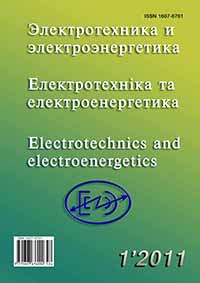Control of coordinates electric drives based on the concept of inverse dynamics problems for minimization local functionals momentary values of energy
DOI:
https://doi.org/10.15588/1607-6761-2011-1-6Keywords:
concept of the inverse dynamics problems, desired quality of control, regulator, parametric indignationAbstract
Mentioned in title method used to improve the quality of the speed control of electric drives, provides weaken sensitivity to parametric indignations and simple decomposition of the system.References
Башарин А. В. Управление электроприводами / А. В. Башарин, В. А. Новиков, Г. Г. Соколовский. – Л. : Энергоиздат, 1982. – 392 с.
Терехов В. М. Системы управления электроприводов / В. М. Терехов, О. И. Осипов. – М. : Академия, 2005. – 300 с.
Белов М. П. Автоматизированный электропривод типовых производственных механизмов и технологических комплексов/ М. П. Белов, В. А. Новиков, Л. Н. Рассудов. – М. : Академия, 2007. – 576 с.
Черноусько Ф. Л. Декомпозиция и субоптимальное управления в динамических системах / Черноусько Ф. Л. // ПММ. – 1990. – Т. 54. – Вып. 6. – С. 883–893.
Крутько П. Д. Симметрия – етодологическая основа формулирования обратных задач динамики и методов их решения / П. Д. Крутько // Изв. РАН. ТиСУ. – 2004. – № 1. – С. 5–26.
Крутько П. Д. Робастно устойчивые структуры управляемых систем высокой динамической точности. Алгоритмы и динамика управления движением модельных объектов / П. Д. Крутько // Изв. РАН. ТиСУ. – 2005. – № 2. – С. 120–140.
Островерхов Н. Я. Метод синтеза регуляторов электромеханических систем на основании концепции обратных задач динамики в соединении с минимизацией локальных функционалов мгновенных значений энергий движения / Н. Я. Островерхов // Вестник НТУ «ХПИ». – Харьков : НТУ «ХПИ», 2008. – № 30. – С. 105–110.
Downloads
How to Cite
Issue
Section
License
Copyright (c) 2017 M.Ya. Ostroverkhov, M.P. Buryk

This work is licensed under a Creative Commons Attribution 4.0 International License.
Creative Commons Licensing Notifications in the Copyright Notices
Authors who publish with this journal agree to the following terms:
Authors retain copyright and grant the journal right of first publication with the work simultaneously licensed under aCreative Commons Attribution License that allows others to share the work with an acknowledgement of the work's authorship and initial publication in this journal.
Authors are able to enter into separate, additional contractual arrangements for the non-exclusive distribution of the journal's published version of the work (e.g., post it to an institutional repository or publish it in a book), with an acknowledgement of its initial publication in this journal.
Authors are permitted and encouraged to post their work online (e.g., in institutional repositories or on their website) prior to and during the submission process, as it can lead to productive exchanges, as well as earlier and greater citation of published work.

